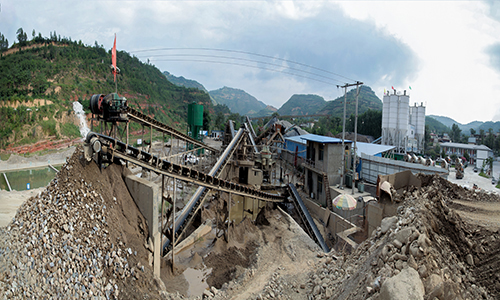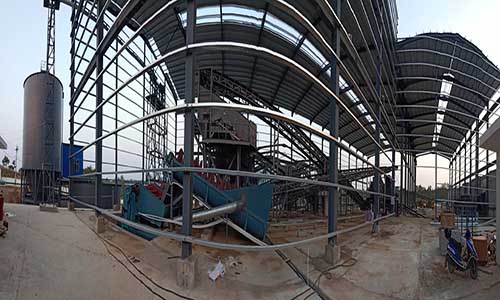اترك رسالة

MaterialsEffect of grinding on chemical and physical
The particle size of rice husk ash decreases with an increase in grinding time [23] husk ash consists of irregularshaped particles with a sizable fraction showing a porous cellular structure After grinding, the rice husk ash consists mainly of fine Only a small amount of rice husk is used for extraction of silica in an industrial scale This chapter presents a general review on the physicochemical Rice Husk, Rice Husk Ash and Their Applications

IOP Conference Series: Materials Science and Engineering PAPER
The chemical composition of untreated rice husk ash (URHA) and treated rice husk ash (TRHA) were analysed by Xray fluorescence spectrometer (XRF) particle size of nano Rice Husk Ash (nRHA) at various grinding durations The resul ts, presented in Fig 5 and Fig 6,reveal the mean particle sizes of Effects of Milling Time on Nano Rice Husk Ash Particle Size

Rice husk ash ScienceDirect
Physical, chemical and morphological characteristics of Rice Husk Ash (RHA) are discussed and the effect of rice husk combustion conditions on these Fig 3: Schematic shape of rice husk ash furnace (Ramezanianpou r et al, 2009) Fig 4: Furnace at UKM for burning rice husk (Zain et al , 2011) amount amorphous silica conten t about 974%Utilization of Rice Husk Ash for Sustainable

Effects of ultrasonic surface treatment on rice husk carbon
In this study, the different effects of ultrasonic surface treatment on rice husk carbon (RHC) were studied The RHC was treated by ultrasound in water, silane, of treated rice husk ash (UFTRHA) The UFTRHA was produced at 600℃ and pretreated with 01M hydrochloric acid (HCl) at 80℃ for 4 hours of the soaking period will be INFLUENCES OF GRINDING PROCESS ON THE PHYSICAL AND

Untreated rice husk ash incorporated high strength self
Rice husk ash (RHA) Effect of grinding of lowcarbon rice husk ash on the microstructure and performance properties of blended cement concrete Cem Concr Rice husk ash (RHA) is produced by the controlled incineration of rice hulls and consists of 85–95 wt% amorphous silica [20, 39] The improper disposal of RHA generates several environmental issues, such as the formation of ash lands, air pollution, and water contamination, all of which are hazardous to human health [ [41],[42],[43] ]Development and characterization of eco and userfriendly grout
Rice Husk: A Potent Lignocellulosic Biomass for Second Springer
The slurry provides better substrate bioavailability for the bacteria On the other hand, dry grinding involves rice husk powder formation without the use of water As per the current findings, grinding and milling pretreated rice husk has no significant statistical difference between their bioethanol productions (Fig 10)Locallyproduced RHA samples were obtained by burning rice husk at a specified temperature of 600 °C for two hours at a heating rate of 20 °C/min in an electronic furnace For the grinding process, a laboratory stainless ball mill manufactured by Nanjing University, Nanjing, China, was used to grind the raw ash to smaller particlesPozzolanic Reactivity of Silica Fume and Ground Rice Husk Ash as

Rice HuskDerived Nanomaterials for Potential Applications
21 Rice Husk Composition RH is the paddy cereal’s outermost layer, which is isolated from the rice cereals during the grinding operations The chemical components of RH are varied from one sample to another due to the kind of paddy, crop time, climate, and geographical circumstances The RH is a deficient nourishment Highlights Residual rice husk ash (RHA) from South Vietnam as a pozzolanic material The nonground RHA can be applied as a pozzolanic material Compressive strength of cylindrical concrete in the 47–66 MPa range was obtained Without adversely affecting the properties of concrete up to 20% of RHA replacementEffect of rice husk ash on the strength and durability characteristics

Experimental study on the freezing resistance and ScienceDirect
This study illustrates the significant influences of rice husk ash (RHA) addition on the mechanical properties, freezing resistance and microstructure of alkaliactivated slag (AAS) material The results indicate that the incorporation of rice husk ash enhanced the compressive strength, and reduced the mass loss percentage and Rice husk ash concrete (RHAC) is a new type of concrete that has been rapidly gaining acceptance in recent years In this paper, the improvement effect of rice husk ash (RHA) on the sulfate erosion performance of concrete was confirmed The ratio of rice husk ash concrete (RHAC) was optimized and compared with ordinary concrete Performance degradation and damage model of rice husk ash

Effect of rice husk ash on the strength and durability characteristics
Abstract This work investigates the effects of adding residual rice husk ash (RHA) from South Vietnam, generated when burning rice husk pellets in the boiler, to cement To improve pozzolanicOn the contrary, considerable amounts of rice husk ash (RHA), palm oil fuel ash (POFA), and sugarcane bagasse ash (SBA) are dumped in open landfills, resulting in water and land pollution The use of RHA, POFA, and SBA as cementitious supplementary materials to develop sustainable concrete presents a potential solution to Microstructure, strength, and durability of ecofriendly concretes
Strength, permeability and microstructure of selfcompacting concrete
Selfcompacting concrete (SCC) is characterized by deformability and segregation resistance It flows under its own weight while remaining homogeneous in composition This study presents the effect of replacing cement content with rice husk ash (RHA) as supplementary cementitious materials ('s) in SCC and observing fresh The rice husk ash in the specimen has high pozzolanic properties The highly active SiO 2 reacts with Ca(OH) 2 generated during the hydration reaction to form CSH gel, which fills holes and gaps, improves the compactness, alleviates the damage caused by the dry–wet cycle process, and improves the compressive strength and Mechanical Properties and Microstructure of Rice Husk Ash
Influence of rice husk ash (RHA) on the properties of self
Rice husk ash should be produced with suitable specifications for a specific use as crystalline and amorphous forms of silica have different properties [4], reported after burning RHA samples at 700 °C for 6 h and wetgrinding (80 Ultrasonic pulse velocity (UPV)On average each tonne of rice produces 200 kg of ricehusks, which on complete combustion lead to 40 kg of RHA No other crop residue generates a greater quantity of ash when it is burnt A hard estimation indicates that near 320,000 t/year of RHA could be generated at the region, and adequate alternative dispositions must be planned Concrete incorporating ricehusk ash without processing

Effects of ultrasonic surface treatment on rice husk carbon
Abstract In this study, the different effects of ultrasonic surface treatment on rice husk carbon (RHC) were studied The RHC was treated by ultrasound in water, silane, and polyphosphoric acid Particle size, chemical changes of the surface, dispersion, and surface area were all investigated The ultrasonic treatment in acid increased theFour rice husk ashes with different finenesses, ie coarse original rice husk ash (RHA0), RHA1, RHA2, and RHA3 were used for the study Ordinary Portland cement (OPC) was partially replaced withEngineering Properties of Normal Concrete Grade 40 Containing Rice Husk
Influence of different processing methods on the
Another application of rice husk ash is its use as an insulation powder in steel casting tundish (Kim et al, 2017) Sugarcane bagasse ash (SCBA) can be used in the rubber industry as a replacement for commercial silica (Torres et al, 2021), as a filter, soil stabilization (James and Pandian, 2017)Specific gravity The effect of grinding on the density of rice husk ash is shown in Fig 1 The density of the OPC is 314 g/cm3 The densities of RHA0, RHA1, RHA2, and RHA3 are 198, 215, 221, and 223 g/cm3, respectively After 240 min, the density of the original rice husk ash increases from 198 to 223 g/cm3Effect of grinding on chemical and physical properties of rice husk ash

Utilization of high volumes of unprocessed lignitecoal fly ash
Pozzolans from industrial and agricultural byproducts, such as lignitecoal fly ash (FA), rice husk ash (RHA), bagasse ash (Suaiam and Makul, 2013b), cathode ray tube funnel glass sand (Zhao et al, 2013), and recycling concrete (Barbudo et al, 2013), are receiving increasing attention as their inclusion generally improves the properties of Abstract This paper investigates the effects of adding natural rice husk ash collected from uncontrolled burning and without previous grinding (NRHA) as cement replacement in concrete To obtain an adequate particle size, NRHA was mixed with coarse aggregate for a convenient period of time before adding the other components Abrasion resistance and compressive strength of unprocessed rice husk
